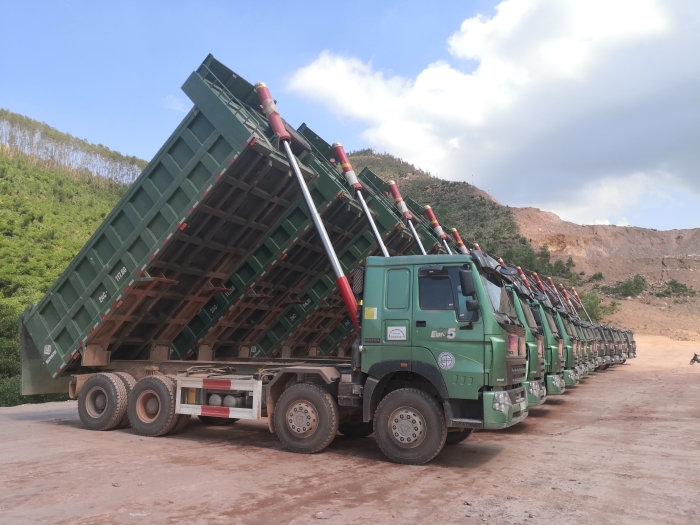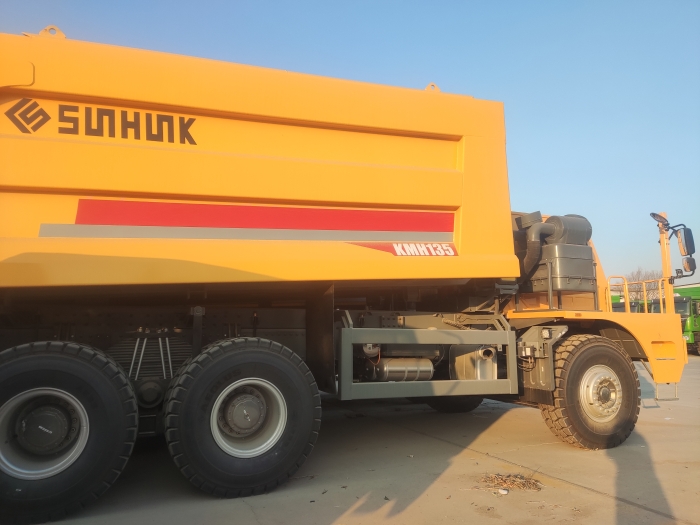- PRODUCTS
- SOLUTION
- SERVICE
- NEWS
- ABOUT US
Cargo semi-trailers offer flexible road transport for diverse loads, while standard shipping containers provide uniform dimensions and are optimized for multimodal transport efficiency.
Semi-trailers, a crucial component of the road transport industry, offer unique structural characteristics that enable them to efficiently transport a wide range of goods. The basic construction of a semi-trailer involves a frame that supports the cargo area, wheels, and a coupling mechanism to attach to a tractor unit. Specifically, semi-trailers typically do not have a front axle, allowing the front end to rest on the tractor unit for support.
Wheel configurations vary, with common setups including tandem axles (two axles close together) to distribute the weight more evenly. This configuration helps in handling heavier loads and complying with road weight regulations. Some semi-trailers come equipped with lifting axles to reduce tire wear when the trailer is empty or lightly loaded.
The coupling mechanism, usually a fifth wheel coupling, allows for quick and secure attachment to the tractor unit. This design provides the flexibility to connect with various tractor units, enhancing the operational efficiency of semi-trailers in logistics.

Standard shipping containers, pivotal in global trade, exhibit uniform structural features designed for durability, security, and ease of handling. The most common sizes are 20-foot and 40-foot lengths, with standard dimensions set by the International Organization for Standardization (ISO). These containers typically offer an internal volume of about 33.2 cubic meters for 20-foot containers and 67.7 cubic meters for 40-foot containers, enabling substantial cargo space.
Materials used in manufacturing include high-strength corten steel and, in some cases, aluminum for a lighter weight option. Corten steel provides excellent resistance to corrosive elements, ensuring the longevity of containers even under harsh maritime conditions.
Sealing capability is another critical feature, with containers designed to be fully watertight and airtight, protecting the cargo from moisture, dust, and pests. This characteristic is vital for ensuring the safe transport of sensitive goods across different climates and environments.
In terms of transition words to enhance readability, let's explore how these structural differences impact their respective fields. For instance, the semi-trailer's adaptability in coupling with different tractor units streamlines operations within road transport. Conversely, the standardized sizes and robust material choice for shipping containers underscore their indispensable role in facilitating international trade.
Further, exploring these vehicles' design intricacies reveals their tailored approach to meeting the logistic sector's demands. Semi-trailers' wheel configuration and shipping containers' material selection are not mere design choices but strategic decisions aimed at optimizing performance and durability.
For more in-depth information, refer to the semi-trailer's Wikipedia page and the shipping container's Wikipedia page, which offer comprehensive insights into their design and usage in the logistics and transportation sectors.
Semi-trailers offer a unique blend of structure and functionality, designed to be versatile in the world of cargo transport. The fundamental construction of a semi-trailer includes a body without a front axle, relying instead on a tractor unit or a dolly for support and mobility. This design allows for a significant portion of the semi-trailer's weight to be borne by the tractor unit, enhancing its capacity to carry heavier loads.

Key features include:
· Body Structure: Typically, semi-trailers possess a robust frame that can accommodate various types of cargo, from standard palletized goods to heavy machinery. The construction material often includes high-strength steel or aluminum, offering a balance between durability and weight.
· Tire Configuration: Semi-trailers commonly feature multiple axle configurations, ranging from 2 to 5 axles, to distribute the cargo weight evenly and comply with road weight regulations. This variability ensures optimal flexibility for different load requirements.
· Connection Mechanism: The critical component that attaches the semi-trailer to the tractor unit is the fifth wheel coupling, providing a secure and pivotable link that enables the effective maneuverability of the combined vehicle.
Standard shipping containers, the backbone of global trade, are designed for efficiency, security, and durability. These containers come in standardized sizes, the most common being 20-foot and 40-foot lengths, ensuring compatibility across various modes of transport, from ship to rail to truck.
Notable characteristics include:
· Dimensions: A 20-foot container typically measures 20 feet in length, 8 feet in width, and 8.6 feet in height, whereas a 40-foot container doubles the length without altering the width and height, providing ample space for a wide range of goods.
· Materials: Constructed mainly from corrosion-resistant steel or aluminum, these containers are built to withstand harsh maritime environments, including saltwater exposure, while maintaining the integrity of the cargo.
· Sealing: Designed with water-tight seals, shipping containers offer superior protection against moisture and external elements, ensuring the cargo's safety during long sea voyages.
These design differences between cargo semi-trailers and standard shipping containers highlight the specialized nature of each transport method, addressing diverse needs within the logistics and transportation industry. Transitioning smoothly from road to rail to sea, standard shipping containers exemplify the concept of intermodal freight transport, whereas semi-trailers shine in their capacity for heavy and oversized loads, showcasing the dynamic range of options available for shipping and transportation.
Semi-trailers excel in road transport due to their high efficiency in loading and unloading goods and their adaptability to diverse road conditions. The design of semi-trailers allows for side, rear, and sometimes top loading, which significantly reduces the time spent at loading docks. For instance, a skilled team can load or unload a semi-trailer in less than an hour, depending on the cargo type.
Furthermore, semi-trailers are designed to navigate a variety of road conditions, from highways to rural roads, effectively. Their multiple axle configurations not only distribute weight evenly but also enhance stability and maneuverability, allowing them to maintain speed and efficiency even on less optimal roads.

Standard shipping containers revolutionize transport efficiency through their ease of loading and unloading and their seamless integration into multimodal transport systems. Containers can be quickly transferred from ship to rail to truck, minimizing downtime and reducing handling costs. This process, known as intermodal transportation, leverages containers' standardized sizes for efficient stacking and movement, drastically cutting down on transit times across different transport modes.
The use of specialized equipment, such as cranes and stackers, further enhances the efficiency of container handling, enabling the loading or unloading of a container in just a few minutes under optimal conditions.
When comparing the flexibility of semi-trailers and standard shipping containers, semi-trailers offer superior adaptability in road transport scenarios. They can easily adjust routes in response to traffic conditions, road closures, or last-minute delivery changes. Additionally, the variety of semi-trailer types (flatbed, refrigerated, tanker, etc.) allows for the transportation of a wide range of goods, from perishables to hazardous materials, catering to specific cargo needs on the fly.
In contrast, standard shipping containers excel in their ability to switch between transport modes without unloading the cargo. This multimodal flexibility makes containers ideal for long-distance and international shipments, where goods must travel via sea or rail before reaching their final road transport destination. However, once on the move, containers lack the same level of route flexibility as semi-trailers, largely dependent on pre-established shipping lanes and rail networks.
In conclusion, both semi-trailers and standard shipping containers offer distinct advantages in terms of efficiency and flexibility. Semi-trailers stand out for their quick loading times and adaptability on the road, while standard shipping containers provide unmatched efficiency in intermodal transport, making each indispensable in the global logistics and transportation industry.
Maintaining a semi-trailer for long-term use involves regular inspections and upkeep to ensure its reliability and safety on the road. Key maintenance activities include:
· Tire Replacement and Rotation: Regular checks for wear and tear are crucial, as tires are essential for the safe handling and transportation of goods. Industry standards suggest inspecting tires every 10,000 miles and rotating them to promote even wear.
· Brake System Inspections: Given the heavy loads semi-trailers carry, maintaining the brake system is vital for safety. Operators should perform checks at least twice a year, focusing on brake pad thickness and air brake system integrity.
· Structural Integrity: Semi-trailers require inspections for potential structural issues, such as rust or frame damage, which could compromise the vehicle's safety and functionality. These checks should occur annually to identify and address any concerns early.

Standard shipping containers are designed for durability, with a typical lifespan of 10 to 15 years in harsh maritime environments. Their construction allows them to withstand extreme conditions, including:
· Resistance to Corrosive Elements: Made from corrosion-resistant materials like Corten steel, containers can endure saltwater exposure, a common scenario during sea transport. This material significantly reduces the rate of corrosion compared to standard steel.
· Low Maintenance Needs: Containers require minimal upkeep, primarily focusing on ensuring door seals remain intact and the structure is free from significant dents or deformations that could compromise the container's integrity.
The financial aspects of utilizing semi-trailers and shipping containers encompass both initial acquisition costs and ongoing operational expenses:
· Semi-Trailers: The purchase price for a new semi-trailer ranges from $20,000 to $80,000, depending on the type and specifications. Operational costs include fuel consumption, which varies by distance and load, and regular maintenance expenses to ensure safety and efficiency.
· Shipping Containers: A new 20-foot standard container can cost between $2,000 and $4,000, while a 40-foot container might range from $4,000 to $6,000. Operational costs for containers are generally lower, focusing on transport fees across different modes and minimal maintenance costs.
Both semi-trailers and shipping containers play pivotal roles in the global supply chain, each with its maintenance and cost profiles. Semi-trailers demand more frequent maintenance due to their complex mechanical components and direct road exposure. In contrast, shipping containers offer remarkable durability with minimal upkeep, making them cost-effective for long-term use in transporting goods across vast distances. The choice between these options depends on specific transportation needs, budget constraints, and logistical considerations, highlighting the importance of understanding these factors in the efficient and effective movement of cargo.